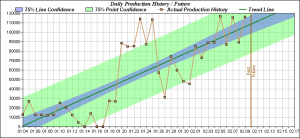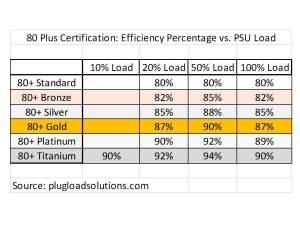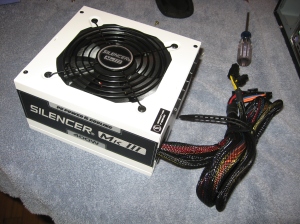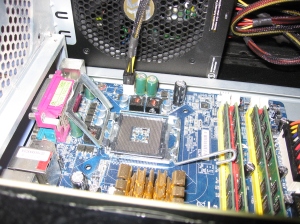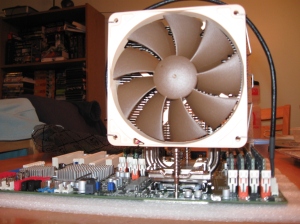Since the dawn of Folding@Home, Stanford’s single-threaded CPU client known as “uniprocessor” has been the standard choice for stable folding@home installations. For people who don’t want to tinker with many settings, and for people who don’t plan on running 24/7, this has been a good choice of clients because it allows a small science contribution to be done without very much hassle. It’s a fairly invisible program that runs in the background and doesn’t spin up all your computer’s fans and heat up your room. But, is it really efficient?
The question, more specifically targeted for folding freaks reading this blog, is this: Does the uniprocessor client make sense for an efficient 24/7 folding@home rig? My answer: a resounding NO! Kill that process immediately!
A basic Google search on this will show that you can get vastly more points per day running the multicore client (SMP), a dedicated graphics card client (GPU), or both. Just type “PPD Uniprocessor SMP Folding” into Google and read for about 20 minutes and you’ll get the idea. I’m too lazy to point to any specific threads (no pun intended), but the various forum discussions reveal that the uniprocessor client is slower than slow. This should not be surprising. One CPU core is slower than two, which is slower than three! Yay, math!
Also, Stanford’s point reward system isn’t linear but exponential. If you return a work unit twice as fast, you get more than twice as many points as a reward, because prompt results are very valuable in the scientific world. This bonus is known as the Quick Return Bonus, and it is available to users running with a passkey (a long auto-generated password that proves you are who you say you are to Stanford’s servers). I won’t regurgitate all that info on passkeys and points here, because if you are reading this site then you most likely know it already. If not, start by downloading Stanford’s latest all-in-one client known as Client V7. Make sure you set yourself up with a username as well as a passkey, in case you didn’t have one. Once you return 10 successful work units using your passkey, you can get the extra QRB points. For the record, this is the setup I am using for this blog at the moment: V7 Client Version 7.3.6, running with passkey.
Unlike the older 6.x client interfaces, the new V7 client lets you pick the specific work package type you want to do within one program. “Uniprocessor” is no longer a separate installation, but is selectable by adding a CPU slot within the V7 client and telling it how many threads to run. V7 then downloads the correct work unit to munch on.
I thought I was talking efficiency! Well, to that end, what we want to do is maximize the F@H output relative to the input. We want to make as many Points per Day while drawing the fewest watts from the wall as possible. It should be clear by now where this is going (I hope). Because Stanford’s points system heavily favors the fast return of work units, it is often the case that the PPD/Watt increases as more and more CPU cores or GPU shaders are engaged, even though the resulting power draw of the computer increases.
Limiting ourselves to CPU-only folding for the moment, let’s have a look at what one of my Folding@Home rigs can do. It’s Specs Time (Yay SPECS!). Here are the specs of my beloved gaming computer, known as Sagitta (outdated picture was up at the top).
- Intel Q6600 Quad Core CPU @ 2.4 GHz
- Gigabyte AMD Radeon HD 7870 Gigahertz Edition
- 8 GB Kingston DDR2-800 Ram
- Gigabyte 965-P S3 motherboard
- Seasonic X-650 80+ Gold PSU
- 2 x 500 GB Western Digital HDDs RAID-1
- 2 x 120 MM Intake Fans
- 1 x 120 MM Exhaust Fan
- 1 x 80 MM Exhaust Fan
- Arctic Cooling Freezer 7 CPU Cooler
- Generic PCI Slot centrifugal exhaust fan

Ancient Pic of Sagitta (2006 Vintage). I really need to take a new pic of the current configuration.
You’ll probably say right away that this system, except for the graphics card, is pretty out of date for 2014, but for relative A to B comparisons within the V7 client this doesn’t matter. For new I7 CPUs, the relative performance and efficiency differences seen by increasing the number of CPU cores for Folding reveals the same trend as will be shown here. I’ll start by just looking at the 1-core option (uniprocessor) vs a dual-core F@H solve.
As you can see, switching to a 2-CPU solve within the V7 client yields almost twice as many PPD (12.11 vs 6.82). And, this isn’t even a fair comparison, because the dual-core work unit I received was one of the older A3 cores, which tend to produce less PPD than the A4 work units.
In conclusion, if everyone who is out there running the uniprocessor client switched to a dual-core client, FOLDING AT HOME WOULD BECOME TWICE AS EFFICIENT! I can’t scream this loud enough. Part of the reason for this is because it doesn’t take many more watts to feed another core in a computer that is already fired up and folding. In the above example, we really started getting twice the amount of work done for only 13 more watts of power consumed. THIS IS AWESOME, and it is just the beginning. In the next article, I’ll look at the efficiency of 3 and 4 CPU Folding on the Q6600, as well as 6-CPU folding on my other computer, which is powered by a newer processor (AMD Phenom II X6 1100T). I’ll then move on to dual-CPU systems (non BIGADV at this point for those of you who know what this means, but we will get there too), and to graphics cards. If you think 12 PPD/Watt is good, just wait until you read the next article!
Until next time…
-C


